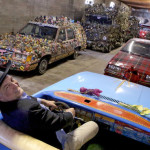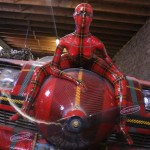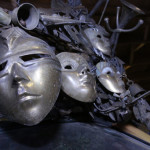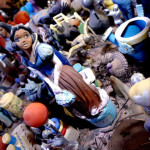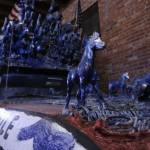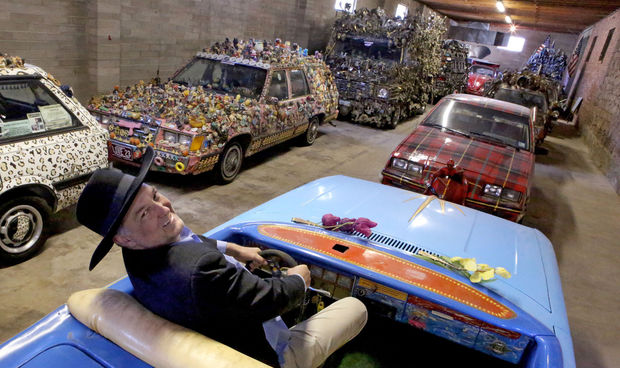
DOUGLAS — Slathered in an off-pink paint that clogs the stonework, the building at the corner of Ninth Street and H Avenue has seen better days. But step behind the aging facade and you enter a world of art, obsession and wonder — all on wheels.
The Art Car World museum is home to 23 vehicles that are as unique as the people and circumstances that produced them, said Harrod Blank, artist, filmmaker and the museum’s creator.
There’s the Coltmobile, covered in 1,400 blue horses — one for every time its creator, a recovering alcoholic, wanted a drink. The Carthedral, a fusing of hearse and Volkswagen Beetle, towers as a gothic dream with gargoyles and stained glass windows.
“Cumulatively, this is lifetimes of work. A whole man’s life made just that one. You could not duplicate that if you tried,” Blank said, pointing to the California Fantasy Van. Made by a vacuum-cleaner repairman in California, the 1975 GMC van jingles and jangles with thousands of riveted brass items and $15,000 in coins.
“That’s how intensive these things are, how special — and you can only see them in Douglas,” he said.
The museum, open by appointment only, is a testament to Blank’s passion for art cars and the movement he helped define.
Drivable art
Nobody knows for sure who made the first art car, who looked at a ton of steel and decided it would make a great canvas, but self-expression was definitely the reason, artists said.
Blank, now 52, was 17 when he decided his first car, a beat-up, 1965 white VW Beetle, did not represent who he was. He painted a rooster on the door. People thought it was cool, and it pushed him to do more, he said.
By the time he left college, his Beetle was painted in multiple colors, with all sorts of decorations glued inside and outside. It had transformed into the Oh My God!, named after people’s reaction to the car.
Having studied filmmaking, Blank shot a documentary about art cars, called “Wild Wheels.” He also wrote a book by the same name, both in an effort to capture and celebrate art cars and their creators.
In 1993, he started working on his second art car, the Camera Van, which was covered with more than 2,000 cameras and assorted photography paraphernalia. It took him two years to complete.
Throughout his efforts, his mother and father, Gail and Les Blank, both artists, were very supportive, he said.
“The average parent would probably scold their kid if they spent two years gluing cameras to their van when they’re 32 years old,” Blank said. “My father did say, ‘When are you going to get a job?’ But he didn’t stop me.”
Since then, Blank has written another book about art cars and directed another full-length documentary, “Automorphosis.”
While people’s reasons for creating an art car may differ, part of the appeal is the transgressive nature of the movement.
“We’ve been brainwashed to think that our car is a status symbol of wealth, status in society, sanity,” Blank said. “You’re messing with the image of the car, and you’re not supposed to do that.”
Tucson artist Diane Bombshelter said pushing those boundaries could be inspiring.
“Breaking that taboo opens people’s minds. It doesn’t have to be a certain way; it can be this way, too,” she said. “A little kid sees it, and next thing you know, he wants to be an artist or wants to be an art car artist. That’s fabulous.”
Bombshelter has made two art cars so far. One of them, Bottle of Doom, is at the Art Car World museum. Taking part in an art car parade in San Francisco as a guest of Bisbee artist Kathleen Pearson motivated her to make her own, she said.
“Just to see the look on people’s faces — they instantly smile, and they start waving and get all excited,” Bombshelter said. “It was infectious, their joy. I wanted to do that. I wanted to bring art to the public, instead of the public having to go to an art gallery.”
The irony of setting up a museum for art cars is not lost on Blank, who said a vital component of any art car is that it is, well, a car.
“That’s where all the magic is,” he said. “They’re nice here for you seeing them in one place, but they’re really much nicer driving around.”
Still, the museum offers not only a great opportunity for people to see the cars, but also a way to preserve what can be an ephemeral art form.
Owners have generally donated their art cars to the museum, which is a nonprofit.
“Either they get old and they can’t take care of it or parking is a big problem so they don’t know where to put it,” he said. “Rather than let it go to hell in the front yard, they put it here.”
Douglas dream
The Art Car World museum came to Douglas thanks to Bisbee artist Pearson, who convinced Blank that he would find cheap land and a better fit in the border community.
“The architecture is lovely in Douglas,” she said. “The people are lovely.”
Pearson, who made her first art car in Bisbee in 1990, is represented in the museum by Love 23, a station wagon covered with 5,000 pop-culture objects on the outside and 1,000 more on the inside.
Following her advice, Blank visited Douglas, and in 2005, bought the old Nelson’s Glass building on Eight Street, with hopes of opening the museum fairly quickly.
The building was in disrepair, but he saw its potential as a multidisciplinary art space.
“Then I learned the hard way how much it takes to make a new roof, because that roof was caving in,” he said.
With help from like-minded members of the community, Blank has slowly moved toward opening the museum to the general public. In 2011, he bought the building on Ninth Street and moved the art cars there.
On a weekday in late November, Blank finished setting up metal I beams to support the roof.
“We had to do it to code, we had to have it engineered. People are shocked by that, and I was shocked doing it,” he said. “We’re going to move these big metal beams?”
His plan for both buildings is to not only have the museum, featuring space for each car with video monitors showing the story behind their creation, but to also offer artist workspaces and living quarters.
He wants to connect the two properties and add a gazebo to the top of the Nelson’s Glass building, and on top of that have a turntable with a replica of his Oh My God car serving as a beacon of art, Blank said.
Even in its unfinished state, the museum has attracted visitors from all over the world, he said. He has already had interest on the upstairs artist rooms, which he hopes will be ready in May.
“You’ll enter into a world. A world where art is king and everything is about art — making art, selling art, living art,” Blank said. “That’s the big dream.”
Article VIA: Arizona Daily Star
Images by A.E. Araiza / Arizona Daily Star

